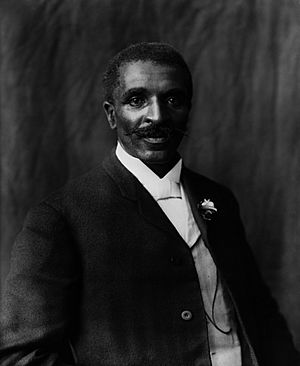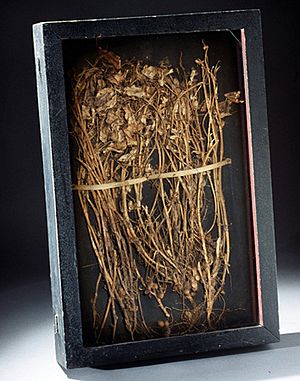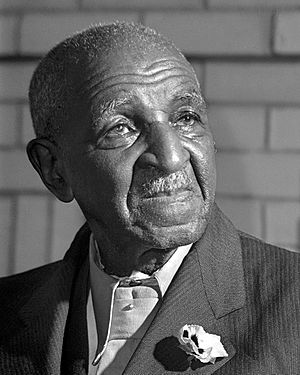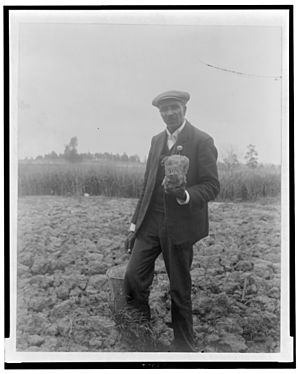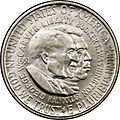George Washington Carver facts for kids
Quick facts for kids
George Washington Carver
|
|
|---|---|
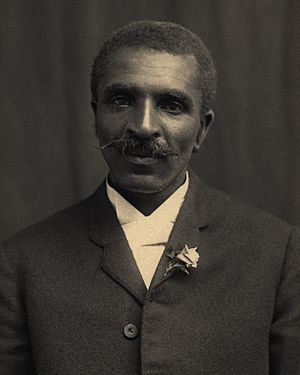
Photograph circa 1910
|
|
| Born | 1864 Diamond, Missouri, U.S.
|
| Died | January 5, 1943 (about 79 years old) Tuskegee, Alabama, U.S.
|
| Alma mater | Iowa State University |
| Awards | Spingarn Medal (1923) |
| Signature | |
George Washington Carver (born around 1864 – died January 5, 1943) was an amazing African American scientist and inventor. He focused on agriculture, which is the science of farming. Carver taught farmers in the southern United States how to grow different crops besides cotton. This helped keep the soil healthy and prevented it from wearing out.
Carver also worked to protect the environment. He received many awards for his important work. One of these was the Spingarn Medal from the NAACP.
Contents
- George Washington Carver's Early Life
- George Washington Carver's College Journey
- Carver's Work at Tuskegee Institute
- How George Washington Carver Became Famous
- Carver's Life as a Famous Scientist
- George Washington Carver's Death
- George Washington Carver's Legacy
- Famous Quotes by George Washington Carver
- Interesting Facts About George Washington Carver
- See also
- Images for kids
George Washington Carver's Early Life
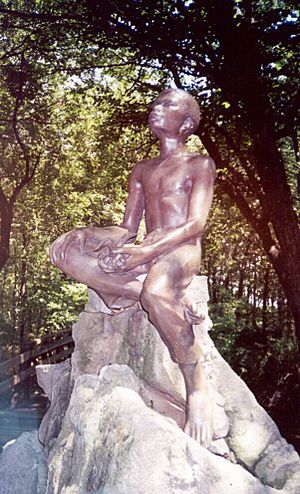
George Washington Carver was born into slavery in the 1860s. This was near a place called Diamond, Missouri. His exact birth date is not known, even to him. But it was before slavery ended in Missouri in January 1865. This happened after the American Civil War.
George's owner, Moses Carver, was a German-American immigrant. He bought George's parents, Mary and Giles, in 1855. When George was just a week old, he, his mother, and a sister were kidnapped. This happened during a night raid by people from Arkansas. They were sold in Kentucky.
Moses Carver hired someone to find them. Only baby George was found and brought back. After slavery ended, Moses Carver and his wife Susan raised George and his older brother James. They treated them like their own children. They encouraged George to go to school. Susan taught him how to read and write.
Black people were not allowed to attend the public school in Diamond Grove. So, George decided to go to a school for black children. It was 10 miles (16 km) away in Neosho. When he got there, the school was closed. He slept in a barn nearby. The next morning, he met a kind woman named Mariah Watkins. He wanted to rent a room from her.
He introduced himself as "Carver's George." This is what he had always been called. But she told him his name was now "George Carver." George liked Mariah Watkins very much. Her words made a big impact on him. She said, "You must learn all you can, then go back out into the world and give your learning back to the people."
When he was 13, George wanted to attend a school in Fort Scott, Kansas. He moved there to live with another foster family. He went to several schools. He finally earned his high school diploma in Minneapolis, Kansas.
George Washington Carver's College Journey
Carver tried to get into many colleges. He was finally accepted at Highland University in Highland, Kansas. But when he arrived, they turned him away because he was black. In 1886, Carver traveled by wagon to Ness County, Kansas. He claimed some land there, like a pioneer.
He grew plants and flowers in a small greenhouse. He also collected rocks. He plowed 17 acres (6.9 hectares) of land by hand. He planted rice, corn, and garden vegetables. He also planted fruit trees and other trees. He earned money by doing odd jobs and working on a ranch.
In 1888, Carver got a $300 loan for his education. He left the area by June. In 1890, Carver began studying art and piano at Simpson College in Indianola, Iowa. His art teacher, Etta Budd, saw that he was very good at painting flowers and plants. She told him to study botany (the study of plants) at Iowa State Agricultural College. This college is now Iowa State University.
He started there in 1891. He was the first black student at Iowa State. Carver wrote his college paper for his agriculture degree in 1894. It was called "Plants as Modified by Man." His professors convinced him to stay for his master's degree. Carver did research at the Iowa Agriculture and Home Economics Experiment Station for two years. His work on plant diseases and fungi made him known as a respected botanist. Carver earned his master's degree in 1896. He also became the first black faculty member at Iowa State.
Carver's Work at Tuskegee Institute
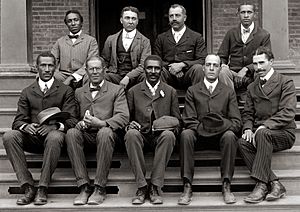
In 1896, Booker T. Washington asked Carver to lead the Agriculture Department at Tuskegee Institute. Carver taught there for 47 years. He made the department a strong place for research. Carver achieved a lot at Tuskegee Institute.
He taught farmers how to rotate their crops. This means planting different crops in the same field each year. He also introduced new crops that farmers could sell. These crops also helped improve the soil. He started research into new uses for crops. He taught many black students farming methods to help them become self-sufficient.
Carver cared about his students' character as much as their learning. He wrote a list of eight good qualities for his students to aim for:
- Be clean both inside and out.
- Neither look up to the rich nor down on the poor.
- Lose, if need be, without complaining.
- Win without bragging.
- Always be considerate of women, children, and older people.
- Be too brave to lie.
- Be too generous to cheat.
- Take your share of the world and let others take theirs.
Carver also created a mobile classroom. It was like a wagon that could travel to farmers. He called it a "Jesup wagon." A rich man named Morris Ketchum Jesup gave Carver money for this program.
How George Washington Carver Became Famous
Carver found ways to improve soil that had lost its nutrients. This happened when farmers grew cotton over and over again. He and other experts told farmers to put nitrogen back into the soil. They did this by rotating cotton crops with sweet potatoes or legumes. Legumes include peanuts, soybeans, and cowpeas. These crops add nitrogen back to the soil and are also good for people to eat.
Farmers who rotated their crops benefited in two ways. Their cotton grew better than before. They also had other crops to sell. To teach farmers how to grow these new crops, Carver created a farming program for Alabama. It was similar to the one at Iowa State.
Carver started a research lab. There, he and his helpers found hundreds of uses for the new crops. They did new research and shared useful ideas. They also shared recipes they had collected from others. Carver shared his information in farming newsletters. He wanted everyone to have access to this valuable knowledge.
Carver became one of the most famous African Americans of his time. Even before he was widely known, leaders in Washington D.C. knew about his work. President Theodore Roosevelt publicly admired him. In 1916, Carver became a member of the Royal Society of Arts in England. This was a rare honor for an American back then.
Carver became most famous for promoting peanuts. The United Peanut Associations of America asked him to speak at their meeting in 1920. He talked about "The Possibilities of the Peanut." He showed 145 different products made from peanuts.
From 1915 to 1923, Carver focused on finding new uses for peanuts, sweet potatoes, and other crops. His assistants also researched existing uses. This work, and his speeches to Congress, made him a public figure. Carver noticed that U.S. peanut farmers were not making much money. This was because imported peanuts were cheaper. He spoke to Congress to ask for a tax on imported peanuts. Congress passed this tax in 1922.
Carver's Life as a Famous Scientist
In the last 20 years of his life, Carver seemed to enjoy being famous. He often traveled to promote Tuskegee Institute, peanuts, and peace between races. He published fewer farming newsletters after 1922. But he wrote articles for peanut industry magazines. He also wrote a newspaper column called "Professor Carver's Advice."
Business leaders came to him for help. He often gave them free advice. Three American presidents met with him: Theodore Roosevelt, Calvin Coolidge, and Franklin Roosevelt. The Crown Prince of Sweden even studied with him for three weeks. From 1923 to 1933, Carver visited white Southern colleges. He did this for a group called the Commission on Interracial Cooperation.
As he became more famous, people wrote books and articles about him. In 1932, it was written that Carver and his peanut products were almost solely responsible for the increase in U.S. peanut farming. This happened after a bug called the boll weevil destroyed cotton crops around 1892.
From 1935 to 1937, Carver worked on a USDA Disease Survey. He had studied plant diseases for his master's degree. In 1937, Carver went to two conferences about chemurgy. This is about using plants to make new products. He was invited by Henry Ford to speak at a conference. They became close friends.
George Washington Carver's Death
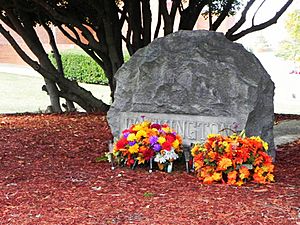
One day, Carver fell down a flight of stairs. A maid found him unconscious and took him to a hospital. Carver died on January 5, 1943, at age 78. He passed away from problems caused by his fall. He was buried next to Booker T. Washington at Tuskegee University.
On his grave, it says: He could have added fortune to fame, but caring for neither, he found happiness and honor in being helpful to the world.
Carver had saved $60,000 in his life. He gave all of it to the Carver Museum and the George Washington Carver Foundation.
George Washington Carver's Legacy
The George Washington Carver Museum at Tuskegee Institute was approved in 1938. It was built and opened in 1941. The Museum held Dr. Carver's large collections of plants, minerals, birds, and vegetables. It also had his products from peanuts, sweet potatoes, and clays. Many of his paintings, drawings, and textile art were there too. In December 1947, a fire broke out in the Carver Museum. Much of the collection was damaged. Time magazine reported that all but three of Carver's 48 paintings were destroyed.
People wanted to create a U.S. national monument to Carver even before he died. Because of World War II, spending on things not related to the war was stopped. But Missouri senator Harry S. Truman supported a bill for a monument. The bill passed. On July 14, 1943, President Franklin D. Roosevelt set aside $30,000 for the George Washington Carver National Monument. This was near Diamond, Missouri, where Carver spent his childhood.
This was the first national monument dedicated to an African American. It was also the first to honor someone other than a president. The 210-acre (0.85 km2) national monument has a statue of Carver. It also has a nature trail, a museum, the 1881 Moses Carver house, and the Carver cemetery. The national monument opened in July 1953.
Carver was featured on U.S. postage stamps in 1948. From 1951 to 1954, his picture was on a special half dollar coin. Another stamp honoring Carver was issued in 1998.
In 1977, Carver was chosen for the Hall of Fame for Great Americans. In 1990, he was added to the National Inventors Hall of Fame. In 1994, Iowa State University gave Carver an honorary degree. In 2000, Carver was one of the first people added to the USDA Hall of Heroes. He was called the "Father of Chemurgy." In 2002, a scholar named Molefi Kete Asante listed George Washington Carver as one of the 100 Greatest African Americans.
In 2005, Carver's research at the Tuskegee Institute was named a National Historic Chemical Landmark. This was done by the American Chemical Society. On February 15, 2005, a TV show called Modern Marvels showed scenes from Iowa State University. It talked about Carver's work.
Two ships were named in his honor: the Liberty ship SS George Washington Carver and the nuclear submarine USS George Washington Carver (SSBN-656). Many places still honor George Washington Carver. A garden and statue of him are in the famous Missouri Botanical Garden in St. Louis. Dozens of schools are named after him. NBA star David Robinson and his wife, Valerie, started a school named after Carver. It opened in 2001 in San Antonio, Texas. The Carver Community Cultural Center in San Antonio is also named for him.
Famous Quotes by George Washington Carver
- "Ninety-nine percent of the failures come from people who have the habit of making excuses."
- "Learn to do common things uncommonly well."
- "There is no shortcut to achievement. Life requires thorough preparation—veneer isn't worth anything."
- "It is simply service that measures success."
- "Start where you are, with what you have. Make something of it and never be satisfied."
- "I love to think of nature as an unlimited broadcasting station, through which God speaks to us every hour if we will only tune in."
- "Reading about nature is fine, but if a person walks in the woods and listens carefully, he can learn more than what is in books, for they speak with the voice of God."
- "The secret of my success? It is simple. It is found in the Bible."
Interesting Facts About George Washington Carver
- George Washington Carver was famous for his work in Alabama. But he was born in Missouri.
- Carver thought many weeds were "nature's vegetables." He would even eat sandwiches made with them.
- George Washington Carver was the first African American to have a national park named after him.
- Carver was also a talented pianist and painter. His art was shown at the 1893 World's Fair in Chicago.
- He encouraged black farmers to grow peanuts. He created and promoted many products from peanuts. But none of them became big sellers in stores.
- Carver is often wrongly given credit for inventing peanut butter. He actually did not invent it.
- Carver helped Henry Ford make rubber from peanuts. This rubber was meant to be used for cannons.
- Carver believed that peanut oil could help people with polio. But there was no scientific proof for this.
- In 1941, Time magazine called Carver a "Black Leonardo."
- He was widely recognized and praised by white communities for his many achievements and talents.
See also
 In Spanish: George Washington Carver para niños
In Spanish: George Washington Carver para niños
- African-American history
- Carver Court, a historic housing development in Chester County, Pennsylvania
- George Washington Carver Center for Arts and Technology, a public high school in Towson, Maryland
- List of people on stamps of the United States
Images for kids



